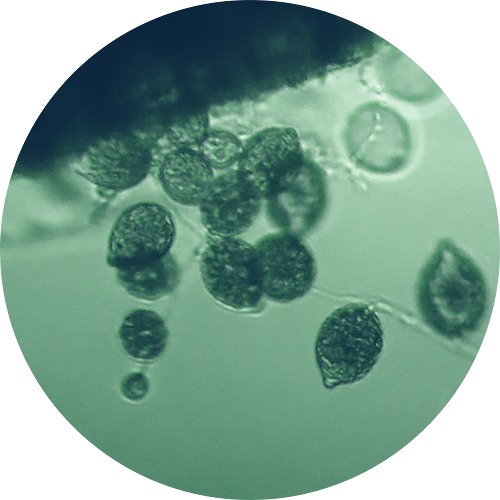
Phytophthora species are microscopic Oomycetes (water molds). Previously considered fungi, these microorganisms are placed in the Stramenopila and are more closely related to the brown algae than to true fungi. More than 120 Phytophthora species have been described to date, and virtually all are plant pathogens. Diseases caused by Phytophthora species include root roots, stem cankers, and blights of fruit and leaves. Host ranges of individual Phytophthora species may be relatively narrow or very wide, encompassing thousands of plant species in many unrelated families. The potential host ranges of most Phytophthora species are unknown because relatively few of these pathogens have been studied in depth, and most studies focus on disease issues in specific crops. When introduced into native ecosystems, various exotic Phytophthora species have proven to be serious to devastating pathogens. Sudden oak death, caused by Phytophthora ramorum and dieback caused by P. cinnamomi are two notable examples.
Commercially-produced nursery stock has long been known to be a primary means by which Phytophthora species have been spread both globally and locally. Parts of your yard and other ornamental landscapes may be infested with Phytophthora species introduced via infested plant material. Recently, increased attention has been placed on the fact that plantings done for ecological restoration projects can introduce exotic Phytophthora species into native habitats. Sampling of multiple native plant nurseries and restoration plantings in California and Oregon has confirmed that a high percentage of native plant nurseries have been infested with multiple Phytophthora species, and these pathogens have been introduced into restoration sites. The pathogen Phytophthora tentaculata, first detected in the US on native plant nursery stock in California, was among the species that have been detected in restoration plantings in California. A USDA risk analysis ranked this species among the five highest Phytophthora species of concern if introduced into the US, due to its potential for environmental and economic impacts.
We have been participating in cooperative efforts to educate native plant nurseries about Phytophthora diseases and their consequences. It is possible to produce nursery plant materials that are free from exotic Phytophthora species. Doing so requires a systems approach to nursery management that accounts for the many ways that these pathogens can be unwittingly introduced into nursery plants. The container nursery environment is highly favorable for the reproduction and spread of root-rotting Phytophthora species. Even a small amount of infective material can quickly spread throughout block or the entire nursery unless thorough phytosanitary practices are followed.